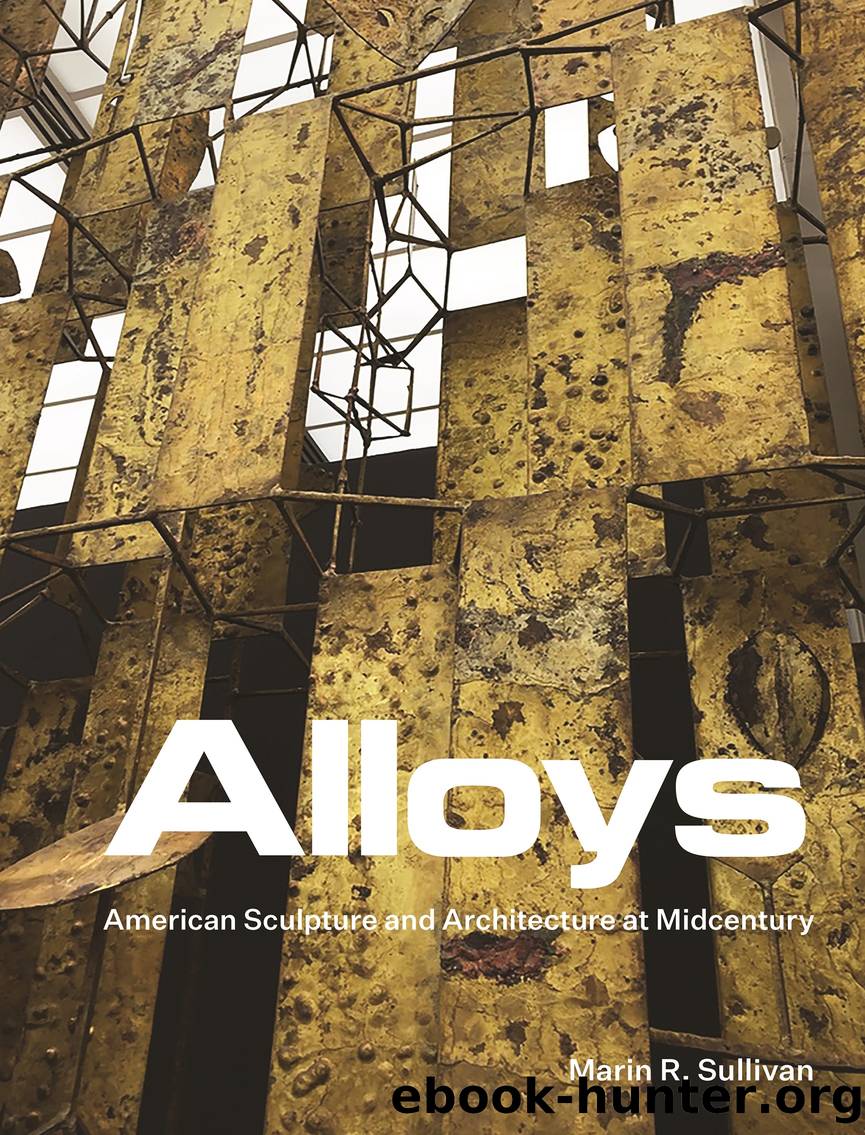Alloys by Marin R. Sullivan

Author:Marin R. Sullivan
Language: eng
Format: epub
Publisher: Princeton University Press
Published: 2021-12-02T00:00:00+00:00
The Reciprocity of Metal
When the Inland Steel Company opened its new building in Chicago in 1958, the companyâs vice president Leigh Block declared that the structure âspelled steel.â By the early 1950s, Chicago outranked Pittsburgh as the steel hub of the United States, and the decision to build a new headquarters in the cityâs downtown Loop was a testament to the rise of the industry there during the immediate postwar period. From the lobby to the executive floors, everything about the new nineteen-story skyscraper served as an advertisement for Inland Steel (figure 3.4). Clad in its namesake product, the shimmering modernist structure made a significant and immediate impression. The Inland Steel Building was the first major structure, the first skyscraper, constructed in the cityâs downtown core in twenty years.
Designed by Skidmore, Owings & Merrill (SOM), the building had no interior support columns, reinforced instead by steel ribs outside of the double-paned, solar-tinted glass curtain wall facade. Attached to the main building was a twenty-five-story windowless service tower, also fully clad in stainless steel, which housed the elevators, restrooms, and the HVAC system, and a two-story annex building, which handled shipping and receiving. The structure did not occupy the entirety of its land site, and the first two floors were set back twenty feet from Monroe Street, creating a small plaza with unobstructed views into its glass and steel-clad lobby, with the upper floors cantilevered to the lot line. Prominently featured in the lobby was Lippoldâs metallic abstract sculpture, Radiant I (1958) (figure 3.5). Visible through the glass curtain walls, the sculpture anchored the space from the center of a shallow pool of water and was set against a highly polished black Belgian marble wall. Radiating outward from the stainless-steel rods of its asterisk core were interlaced wires of gold, stainless steel, and fire-red enamel that diagonally stretched from floor to ceiling, knitting together the surrounding space.9
Radiant I was the result of a collaboration between artist and architect, or in this case a team of architects, but it was also spurred by a very involved client. As William Hartmann, one of the SOM architects involved in the project, remarked, âLeigh Block was a leader of Inland and also of the project. Tremendous recognition and credit should go to him and his participation in it all the way through. Leigh and his wife, Mary, were very important. They had a great interest in art and interiors. Great, great interest in art.â Inland Steel occupied the top eight floors, but the company developed and oversaw the entire building project, which featured an extensive arts program. Leigh and Mary Block were both avid art collectors, and with the permission of the board of directors, bought and installed fifty paintings and seven sculptures for the Inland Steel Building between 1956 and 1958. As Leigh remarked, âOf course, the most important thing is the sale of steel, but on the other hand, we believe that painting and sculpture belong in a modern office building to enhance its beauty.
Download
This site does not store any files on its server. We only index and link to content provided by other sites. Please contact the content providers to delete copyright contents if any and email us, we'll remove relevant links or contents immediately.
| Appreciation | Technique |
Picasso by Gertrude Stein(1502)
Modeling the Head in Clay by Bruno Lucchesi(1477)
Auguste Rodin by Rainer Maria Rilke(1362)
Modelling and Sculpture by Albert Toft(1287)
Louise Nevelson by Laurie Wilson(1190)
The Parthenon Marbles by Christopher Hitchens(1149)
You Must Change Your Life by Rachel Corbett(1124)
Antony Gormley on Sculpture by Antony Gormley(1124)
Asmat Art by Dirk Smidt(1102)
The TAB Guide to DIY Welding : Hands-on Projects for Hobbyists, Handymen, and Artists by Jackson Morley(1088)
Greek Art by John Boardman(1084)
Modular Origami Polyhedra by Lewis Simon & Bennett Arnstein & Rona Gurkewitz(1063)
Origami Holiday Decorations by Florence Temko(1008)
Origami for Beginners by Florence Temko(1007)
The Animal Gazer by Edgardo Franzosini(983)
Spiral Jetta: A Road Trip through the Land Art of the American West (Culture Trails) by Erin Hogan(979)
The Autobiography of Benvenuto Cellini (Penguin Classics) by Benvenuto Cellini(971)
Metal Clay Jewelry: Projects. Techniques. Inspirations. by Louise Duhamel(958)
The Pagan's Cup by Fergus Hume(954)
